First, I have to say shame on you Vienna for not offering the ‘City Name’ Card the same way that Innsbruck and Salzburg do. Although I’ve enjoyed my time in the city and the weather has been at Jordan-levels of lovely, it’s been a lot more difficult for me to see things within the city because of the comparatively high prices. I spent the first day, poised with umbrella in hand (the forecast said rain, although it didn’t, and after being caught unaware in Salzburg, I don’t get fooled again) searching for sights to see.
Daniel was right about being over-castled, museumed, and churched in Vienna (several new words I’ve invented, I see). My hostel was only about a 10 minute walk from the edge of the old section of town, and when I reached the large main street separating the official “old” from the new, a huge statue of either Brahms or Beethoven was there to greet me. I could see several church steeples poking up through the trees and buildings ahead of me, each one of them more ornately coated with carvings than the previous, like monstrous upside down ice cream cones. I didn’t know what to see yet, or where to go, so I basically tried to find the tourist information center, just like the previous two cities, and take it from there.
Inside the center, my somewhat cross-eyed desk clerk handed me a packet of information describing the “Vienna Card.” He asked me how long I was staying in the city, and I told him it would only be for two days. “You don’t want one of these cards then,” he said. “They’ll only save you a euro per exhibit you visit. You won’t recover the cost on them unless you are visiting a lot of places.” I pondered it a moment, and told him I wanted to buy the 18 euro card because of the free transport services too. He looked at me severely (or he may have been looking behind me severely; I couldn’t quite tell). “Listen to me son, if that’s all you want, just get the Transport card for 10 euros and you can ride wherever you want.” His advice seemed sound, and it sounded like he was bored enough that he was willing to keep arguing if I objected, so I bought the Transport card and for the first time, let the city keep its odious tourist card.
With my new and extremely detailed street map in hand, I laid out my plans for the next days. There was a place called the Prater that looked interesting, an Islamic Center on the other side of the Danube river, and of course the two massive castles, the Hofburg Palace and the Schönbrunn Palace. Other than that, I figured I would play it by ear and see what I could find!
I used my new transport card to navigate the clean and well-labeled metro system northward from the old city to the Prater, in what was originally a hunt to find an open grocery store but when I saw a massive Ferris wheel over the trees, I figured that since I was in the area I would visit it (as you can probably tell, I was much more relaxed in my sightseeing now that I didn’t have a card granting me automatic free entrance everywhere). The small park linked to above is home to the world’s oldest Ferris wheel, the Riesenrad, which was built in 1897 and rebuilt after its almost total destruction during WWII. For eight euros I took a ride on it, looking out over the old city to the south and the modern skyscrapers on the north side of the Danube to the other side. The afternoon sunset was catching the glass on the Milennium City tower, almost blinding as our conglomeration of ancient spokes and hub rotated slowly for 20 minutes. I shared the cabin with an amorous young Italian couple and a half dozen American women who seemed to be quite concerned about the safety of the wheel (the Italian couple had more important things to think about, such as making out as much as possible in one corner and completely ignoring the scenery).
Grocery store not yet found, I settled for an expensive slice of pizza in the amusement park before heading back to the metro station and going to the Schönbrunn Palace. The station was close to the palace, but after taking a couple hours that evening touring the massive and free public gardens behind the Palace, I’m surprised the city didn’t just bite the bullet and build the station directly into the massive grounds. The palace itself had been closed for hours, but I was surrounded by tourists, joggers, and mothers with strollers enjoying the perfect weather and neatly manicured lawns of the grounds.
To my joy, the Wiener Philharmonic Orchestra was setting up on stage a couple hundred meters behind the church, and although tickets weren’t free to get into the seats, the speakers were large and I wasn’t the only casual tourist leaning against the fence watching the activities. It looked like only a half dozen people had actually purchased tickets and were sitting in the first ten rows, but I’m sure they were having the time of their lives. Cameras zoomed about on cables suspended over my head, and the setup crew for the stage sat on boxes near me and chatted amicably with the Austrian joggers (I assume it was amicably although of course I had no idea). The show started a few minutes after I arrived, and I stayed for 15 minutes leaning against that fence and watching them warm up, and even as I journeyed on to continue walking up the hill pictured at the top of this post, small hidden speakers all over the grounds carried their beautiful chords to my ears, iPod-less for one of the rare times in the trip.
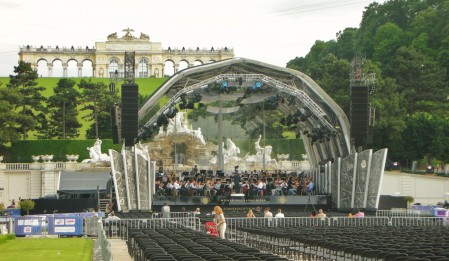
The Gloria secondary hall looms high above as the Orchestra warms up. The music was great but their PR needs to work on attendance!
I knew that I would be coming back again to tour the palace itself, so I made my exit via a side route from the grounds, and spent another hour trying to find a working metro line that would get me back to my hostel. It’s interesting to note that while I was in Vienna, the metro line I was using happened to break both days I was there, but while I was in Cairo two months earlier, there was nary a hitch in metro operation. I sat there in the thankfully well-ventilated train cars with dozens of other bored-looking commuters, wishing that I understood what the voices on the speakers were saying and relying on momentary descriptive kindnesses from the other passengers who saw my bafflement and explained to me that something was broken, again.
Another interesting thing I’ve noticed about all the buses and metro lines throughout Austria (and it was the same in Bavaria, too) is that all of the ticket lines are entirely unmonitored. The turnstiles at the metro entrances have had their ticket collectors removed, and the ticket boxes are just credit card/euro-handling machines that makes it very easy to go for hours of travel without ever interacting with a person. There are signs up that state that to use the metro without a ticket is subject to the choice of an 80 euro fine or an immediate arrest, but they don’t mention that this is only if they catch you. Throughout my 10 days in Austria, using buses everywhere else but the metro in Vienna, I didn’t see a single ticket checker. It was the same way on the short-ride train on the first day to go from the small Munich station to the large one – and that was the one I bought 3 extra tickets for it because I thought I had accidentally stamped the first ones too early! Waste of 7.50 euro, but oh well. I never risked it myself; leery about 80 euros or arrest and with too tight a schedule to risk either of them, but I know that other people had less qualms and got away with minor lawbreaking without a problem. I couldn’t imagine the same system being enforceable in Cairo or New York City, could you? It makes me curious as to what Austria’s mindset about this was when this idea was brought up; as it’s obvious there used to be ticket collecting machines.
I want to give my approval to the hostel I stayed at both nights, the Believe-It-Or-Not. Although I was initially (quite) worried about what I was paying 50 euro for as I climbed cracked and crumbling stone steps inside an unmarked old apartment building, the good reviews on Hostelworld.com proofed correct when Michalis the Greek attendant buzzed me and I saw how the apartment had been completely renovated in a very modern style. Frankly, it looked more like your suave buddy’s apartment in Upper Manhattan than a hostel. Like most of the Europeans I had met so far, Michalis enthusiastically inquired about life working in Jordan, especially when he found I had connections to refugee programs. It’s very interesting but there’s just general public-service wish with many of the people that I ran into, who apparently view refugee work as a high calling. I handed out some business cards and website names, and hopefully they can find some interesting information.
The Believe-It-Or-Not was a great place to stay for 2 nights. It’s one of the rare “all inclusive” hostels that provide you with every necessity as part of the regular price. The Yoho had like most hostels charged me for shampoo, but here there were just dispensers for it in the bathrooms. Free laptops, a big flatscreen, and wifi were in the sunny open central room. Free coffee, uncooked pasta, cookware, juice, milk, and even a bottle of wine were all there to greet the 12 of us – and that number is fully booked. There are only two rooms, an 8 person and a 4 person. I was staying on the “second level” of the 8 person room, an obvious new edition reached by a spiral staircase. But the Believe-it-or-Not got it right: plenty of power outlets. It seems to be a mental plague throughout all hostels I’ve stayed in previously that don’t realize that the formula is # of people X 2 for the minimum number of outlets. We have to charge our cameras and mobiles, after all.
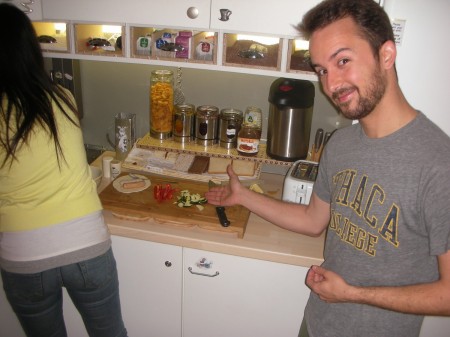
A hostel so good, even Edward Norton stays there! Jesse, a fellow American tourist, displays the breakfast spread.
After a tasty breakfast of toast and cereal the next morning, I returned to the Hofburg castle that I had seen during my walking tour the previous day. Photography was allowed in the first half of it, the Royal Silver Collection, but not in the second half which was a tour through the life of the troubled Empress Sisi, the second-to-late empress of the Habsburg Empire and wife to Franz Joseph. As always, the useful and ever-present audio guides were interesting and informative, and the Silver Collection was a unique and powerful message to the size and age of the Imperial court, with sets of hundreds of silver and gold table sets, a 30-foot long center table spread, and beautifully painted porcelain tablesets (after the silver and gold had been sold to fund the battles against Napoleon), each one entirely unique. The description of the “Foot Washing Ceremony” next to a set of steins and a wooden washtub was very cool; apparently the emperor and empress chose 24 elderly paupers per year and then washed their feet and gave them a royal meal and gifts in the palace. Just as good was the story of Sisi, who apparently became world famous after her assassination for her anguished melancholy and her beauty. They even made a movie about her and spelled her name wrong! The audio guide did a good job giving what would otherwise be a regular “castle tour” into a more personal experience, talking about the good relationship between Franz and his wife, and how much he loved her, even as she slipped into deeper depression. Each room that we were walking through became more than just an old palace-turned-museum, but part of the story of Sisi and Franz…not to mention the countless generations before them, which were not neglected of course!
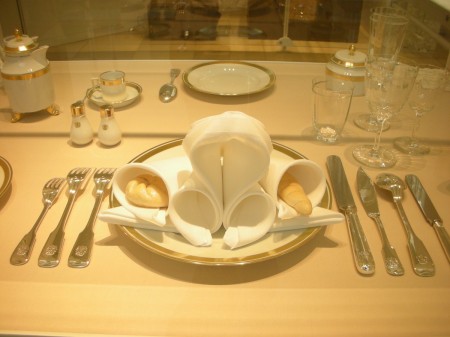
Apparently, this method of napkin folding is a "Secret of the Austrian State" and only five people in the whole world know how to do it. It's still used for state dinners even now.
I used my metro card to cross the Danube river after the castle, because I had read about an “Islamic Center” in Vienna that I thought would be neat to visit. The stations here on this side of the city on a Tuesday before the end of the workday were basically empty, and I was able to easily find the Islamic Center/mosque from its shining white minaret , visible from the other side of the river even as we were crossing over. In front of the quiet building, I found three Arab gardeners, chatting with each other and planting marigolds. From their carefree, jovial conversation and laughter, I (correctly) deduced they were Egyptians before I introduced myself to them in Arabic. “An American that speaks Arabic, here in Austria?” one of them chuckled. “What a strange journey for you!” They didn’t know too much about the center itself, but they told me to go ahead and go inside; no one would mind. Like always, I removed my shoes as I stepped into the prayer area, and sat on the rich carpeting thinking for awhile and staring at the river, visible through the trees to the southwest. There was an Islamic lesson taking place; a covered muhijabeh woman speaking German to a group of young girls and boys seated on the carpet in front of her. They were just finishing up, and as they all rose and the children scattered to play outside, I hailed the woman with a “Salaamu Alayki” which she returned with a smile. She was Turkish, not Arab, like Daniel’s neighbors in Innsbruck, and we couldn’t really communicate, but I expressed my pleasure to her as best I could about seeing girls and boys studying in the mosque together, something that would never happen in Jordan. She knew a bit of Classical Arabic from prayers, but couldn’t have a conversation in it, so I dug deep in my memory to attempt to express myself in the most common Classical phrases I knew. She of course thought I was German and kept trying to talk to me in her second language, although I tried to explain I was an American, like I had with the Egyptians outside. It’s been such a long time since I couldn’t speak Arabic two years ago that I had forgotten how frustrating it is to not be able to communicate when there’s no one bilingual there to help you.
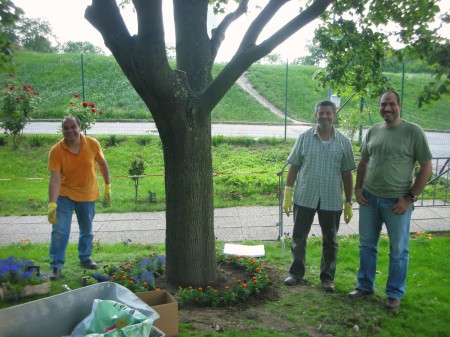
The three Egyptians, hard at work. It must be great for them to be surrounded by so much water and green; they told me they'd been here for 14 years.
Outside again, I asked the Egyptians who the administrator, the sheikh of the building was. They pointed to a well dressed man in a business suit and dark shades, walking towards a large Mercedes. “He’s a Saudi; just came a few months ago to run this place. No one knows much about him; he keeps to himself.” I walked up to the man, who was unlocking his car, and stuck out my hand in a friendly manner and told him, in Arabic, that it was good to see that Muslims living in Austria had a place to go for worship, and asked him how many Muslims there were in his mosque. He regarded me through his shades and asked me where I was from, then after hearing my response asked me in perfect English, “Who wants to know, and why?” He answered my questions briskly and efficiently, then excused himself. I guess I shouldn’t have been surprised at his reaction – when Americans speaking Arabic and inquiring about mosque attendance rates in Europe show up at an Austrian Islamic Center, it’s natural and in fact a bit obvious why a sheikh would be unsure of his visitor’s intentions.
After a few more hours of touring the relatively unremarkable museum housing centuries of obsoleted royal furniture (it was part of my combo ticket that included the Habsburg and Schönnbrun), I returned to the hostel. The wearies of travelers fatigue was definitely starting to catch up me after all this traveling and I was feeling a little ill. I made myself some pasta and retired to bed early.
The next day, as I packed up my suitcase to leave a European place of lodging for the last time, Michalis told me to go ahead and just leave all my bags here while I was doing my last sightseeing at Schönbrunn and he’d let me use one of the lockers (also free, but I thought it was technically for guests who were still paying money). With a lightened spring in my step and feeling better, I entered the massive tourist pack that is Schönbrunn in the morning and waited for half an hour to get into the place. No photography, of course, and although they tried to evoke Sisi and Franz’s love story like the Hofburg had, it wasn’t as effective and in the end the castle was a fancy and very, very large set of beautifully furnished rooms. The audioguide wouldn’t even let us rewind, unlike any of the other ones I’d used, which was obviously intended to hurry us through as quickly as possible. I found this annoying since I’m the kind of person that likes to catch everything the narrator is saying and because of the crowds, that was often difficult. Oh well. Most of the windows were shuttered, but occasionally as we rounded a corner we’d see the beautiful gardens that I’d visited two days ago, or the smaller private gardens that were a separate extra ticket that I didn’t have.
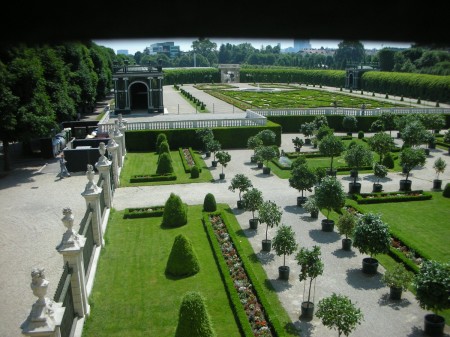
A look over the 'Privy Gardens' that I hastily snapped from the window before the Gendarmes carried me and my camera away
That was all there was too it, and after selecting a few last “Tastes of Austria” from the local grocery store before I left, I retrieved bag from Michalis’ care and bought the out-of-city train ticket that would take me to the Austrian airport. I had to do a bit of shuffling, as my luggage had somehow grown almost seven kilos over the twenty-kilo limit. By the time I walked back to the checkin counter a third time for a reweighing, I was wearing three pairs of pants, four shirts, and I had a sweater tied around my waist in a jaunty fashion. This is all going on with three cans of fine Austrian beer in me and it’s almost thirty degrees outside. The sympathetic check-in woman let me go with my bag still almost two kilos overweight, and I begun the return home to Jordan, heading north to Frankfurt first.
It almost became a rerouting through Israel, though, when they announced over the plane’s loudspeakers that we were going to be delayed by an hour. They read off everyone’s connecting flight and when they mentioned Amman, they said that a flight had been booked going from Germany to Tel Aviv, and then to Amman. I looked down at the black and white, Palestinian keffiyeh I was wearing around my neck and decided I really would rather not deal with the chance of being further delayed by interrogations with the child soldiers I’ve dealt with before at the Jordan/Israeli border. When we touched down, I sprinted across the entire airport and through a large underground terminal transfer line to reach my gate with 5 minutes to spare. Unfortunately for everyone else, they held the plane on my behalf (sorry everyone) because the tickets had already been rebooked going into Israel and my luggage needed to be transferred and reloaded. I sat quietly in my seat. A couple of cute Arab girls a few seats away from me were wearing keffiyehs much like mine, and they looked over at me when I sat down and smiled broadly. I decided I had made the right decision.
It was past two in the morning when our plane touched down in the familiar desert airport of Queen Alia, and I settled in with my luggage outside the terminal for what I assumed would be a long wait until the first Amman/Airport bus arrived at 6:30. I happened to fall into conversation with another man waiting for the bus, a Jordanian named Mohammad who worked with Arab refugees in Norway who was coming home to visit. He was middle aged and quite cheerful for someone non-caffeinated, and after talking for awhile, he asked a sweeper nearby where we could find some coffee, as it was probably obvious that I was quite sleepy. The sweeper said, “Well, there’s shops inside, but those are for the tourists [his eyes swept over me briefly] – if you just want coffee, there’s a little restaurant behind the terminal that has…regular prices.” Mohammad happily bought me several coffees and a Pepsi as we talked about working with refugees, his opinions on life in Europe, and of course our respective families. He even was able to hunt out a bus that was leaving at 4, and helped me load my numerous bags into the back of it.
The sun was mere minutes away over the horizon as we started to tear back towards Amman and the towers that I could see framed in the glow of the morning. The driver switched on the radio and tuned it to al-Athan Fajr, the morning call to prayer. The full bus behind me was suddenly filled with whispered and murmured sounds of people quietly repeating Bismillah al-Rahman al-Raheem…in the name of God, the Ever-merciful and All-merciful. Goats were grazing out in the scrubs of grass out in the gravel and sand a few feet away from the road. It was good to be back.
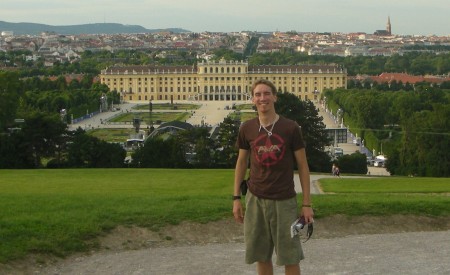
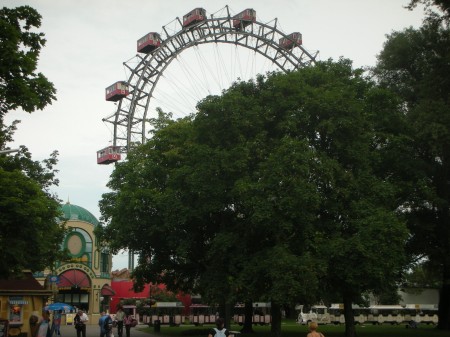


No one has commented on this post - please leave me one, I love getting feedback!
Follow this post's comments, or leave a Trackback from your site